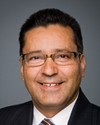Thank you very much, Mr. Chair.
I'm delighted to be here as a recovering politician, somebody who was in the trenches for 24 years and escaped before the posse caught up with me, and I'm delighted to be the honorary chair of QUEST, which is quite a remarkable initiative that was started by the two people beside me here, Mike Cleland from the Canadian Gas Association and Ken Ogilvie from Pollution Probe, a very successful NGO that deals with these issues and has for a very long time--both of these two have. It has become quite an exciting activity over the last two years, and it has grown organically, with a quite impressive variety of people who are participating, from government, from business, from the community.
I thought I'd give you a quick update of where QUEST--Quality Urban and Community Energy Systems of Tomorrow--is at and why we think it's important that you know about us as you launch on this study that you're going to prepare over the next few months and that then will be available, we hope, to be acted on. We have talked to the minister, Lisa Raitt, about our activities and she is quite interested.
I thought we should say, why QUEST? Why are we here before you? I think it's because the communities of Canada represent 50% of Canada's energy use and greenhouse gas emissions. So there's a huge opportunity to deal with some of the issues that we're facing now in terms of climate change and greenhouse gas emissions, and other effects of that.
I would argue, as a former mayor in Vancouver before I was demoted to being premier in British Columbia, that cities are where 100% of the consumption of natural capital, of forest products, agricultural energy, and mineral activities eventually takes place, 75% directly and 25% from the factories and mines and farms and oil and gas, and other activities like that in rural areas that supply our cities with the consumption that takes place there.
So Canada's cities and communities, and we're not just talking of Toronto, we're talking about all of the communities that make up Canada, big, medium, and small.... I was involved in a report I prepared for Prime Minister Martin and handed in to Prime Minister Harper on the national role in Canada's cities and communities. If you want to have a look at that, it describes those kinds of issues. So we think it's important that QUEST exist to start to grapple with solutions to that huge consumption of Canada's energy and creation of greenhouse gas emissions, and we think existing approaches to greenhouse gas mitigation mainly focus on the energy supply issue, and they fall far short, as you can see from grappling with this issue, of the policy targets that we need to make or probably will need to address very actively and aggressively in the next few years.
So we think it's of huge importance to Canada's citizens.
We also believe that an integrated approach is going to bring all kinds of benefits. If you're taking an integrated approach to energy systems in Canada's communities, we believe it will deal with the potential insecurity about energy and some of the other impacts of energy use. It will build a more sustainable energy future, deliver greenhouse gas emissions, let us go to a no or low carbon environment, reduce many other environmental impacts, and provide more affordable energy and more reliable and resilient energy services.
I'll tell you about a remarkable document that the Canadian Gas Association sponsored in 2002-03 for an International Gas Union competition to see what city could come up with a 100-year plan that would address the future shortages of energy. Canada--Vancouver, in particular--won this international competition and put together this project called citiesPLUS--PLUS standing for planning for long-term urban sustainability.
We found that when you backcasted to pick the future community you want for Montreal or for Swift Current or for Prince Rupert, for yourselves and your kids, and you then put a 20-year to 30-year transition strategy in place and then 10-year capital and operational plans, one of the byproducts of that integration of approaches was to dramatically reduce greenhouse gas emissions, 70% to 80%, just by doing what we're talking about.
We think this approach is hugely important for Canada to undertake. We can get you copies of this, Mr. Chair, for your committee members to have a look at. Seven of the world's leading urbanists looked at this very real community called greater Vancouver, with 2.2 million people, being one of the nine finalists to address this series of issues successfully, and they won the grand prize in Tokyo in 2003. So there is a lot of good work that has been done in Canada, and we think QUEST is part of that.
The QUEST vision, as you can see from the material I think you have, is that by 2050--and being the optimist that I am, I hope sooner--every community in Canada will be operating as an integrated energy system, and accordingly, all community development and redevelopment incorporates an integrated energy system. That's our vision.
Our mission is to foster a community-based integrated approach to land use, energy, transportation, waste, and water, and to reduce related greenhouse gas, air pollutant emissions, and waste.
This is the vision and mission that then guided us to becoming much more specific and concrete and community based.
Who is involved in QUEST? If you look at page 8 of the submission, we summarize that we have many federal government departments and organizations involved, a number of provincial governments and municipal governments across Canada, certainly the energy industry, environmental groups, the building sector, and academics. So we have quite an impressive number of people who are involved in this initiative.
I'll just quickly summarize our guiding principles. They're to improve efficiency; to optimize “exergy”, which in simple language means you don't use electricity for space heating, you use more appropriate geothermal, solar, and natural gas, and you use electricity for other power-related activities; reduce waste, and we think there are all kinds of ways, and we've got examples, to reduce waste; use renewable resources more and more; use grids strategically to be able to technically handle renewables and fixed grids and those sorts of very important technical issues.
We think the building blocks are starting to form up across Canada in the following ways: the integration of land use and transportation so that transportation, rapid transit and buses, shape more dense and liveable city centres and transit corridors. So integrate land use, transportation, energy, water, and waste systems. Do not do them separately; combine them.
We think there's an enabling platform for that in higher-density, mixed-use developments of energy efficient buildings. You've heard some examples here today of how that is starting to happen in Canada.
The backbone of it is smart district energy and utility grids that allow better management of available energy.
We think moving to distributed, smaller-scale, local energy systems, which we describe in the citiesPLUS project, is the way we're going to evolve in our communities.
Use local renewables, solar, geothermal, wind, and biomass--and we've certainly got lots of biomass in B.C. with the pine beetle that we're going to have to find a use for.
We're suggesting those are the kinds of directions we need to go in and those are the building blocks.
We have been building momentum, particularly in the last six months or so, from the initial discussion to the point where we've moving to implement. We are looking at a number of demonstration projects in various provinces and municipalities.
In conclusion, we think what the federal government needs to do, and we'll talk about this in questions, is support the move to the QUEST vision from the fringe to the mainstream.
Secondly, there has to be ongoing support for building further momentum. Ensure that technology funding, program funding, infrastructure funding helps create through green infrastructure more sustainable cities and communities, and that integrated energy systems are a central part to that future vision of Canada's cities and communities.
Thank you, Mr. Chair.









